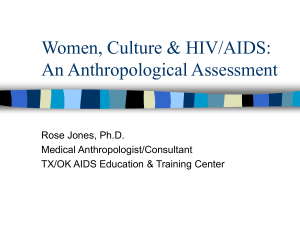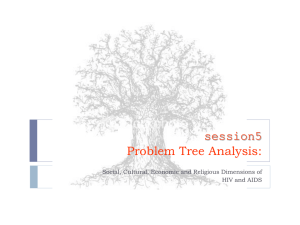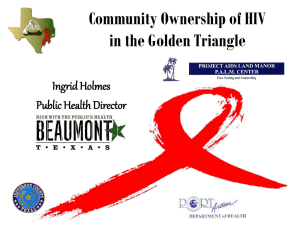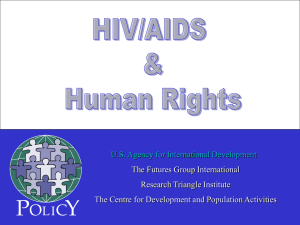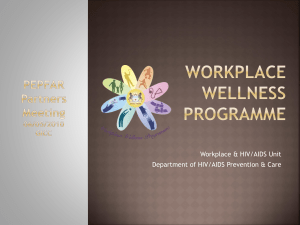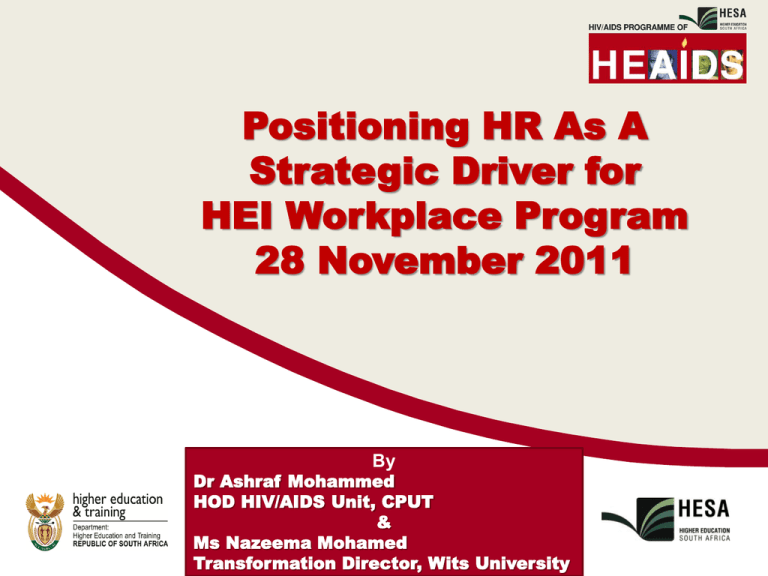
Positioning HR As A
Strategic Driver for
HEI Workplace Program
28 November 2011
By
Dr Ashraf Mohammed
HOD HIV/AIDS Unit, CPUT
&
Ms Nazeema Mohamed
Transformation Director, Wits University
Objectives of Presentation
An overview of workplace programs in higher education;
HIV prevalence in participating higher education institutions;
Legislative Framework framing HIV/AIDS Management;
The key reasons for implementation failure;
Risk analysis for HE
Good Governance in the light of risk – King 3
Corporate Accountability - JSE
Unpacking the implementation inertia
Recommendations
OVERVIEW OF HIV/AIDS
WORKPLACE PROGRAMS IN HEIs
Workplace HIV/AIDS at HEI have NOT seriously gone beyond policies;
Some HEIs have some elements of HIV/AIDS Workplace Programs but
NONE are comprehensive;
Treatment – the prevailing norm is that employees who are members of
medical aid schemes may access private care and the rest must use
state heath services or pay out of pocket;
HEIs have NOT shown committed leadership at all levels of the
Institution which is critical to the success of an HIV/AIDS Workplace
Program;
No HEIs had linked the responsibility of HIV/AIDS Workplace
Programs to the performance contracts of managers
OVERVIEW OF HIV/AIDS
WORKPLACE PROGRAMS IN HEIs
Many HEIs have functioning HICC – but most are within Student Services &
don’t deal adequately with workplace issues;
Staff uptake of HCT at HEIs is less than 5% (exception of 1 HEI)
Absence of comprehensive workplace programmes in HEIs indicates a lack of
engagement with national policy frameworks and the HEAIDS recommendations;
Many HEIs don’t have a dedicated budget for workplace & HIV/AIDS programs;
The majority of institutions still treat HIV and AIDS as only a health issue and
have not mainstreamed HIV and AIDS issues into strategic/operational plans;
King II Report on Corporate Governance finds: “... Little evidence of measures
to promote business sustainability in the face of the pandemic ...”
HIV prevalence of Participating HEIs
(HEAIDS Sero-Prevalence Survey: 2008 – 2009)
Academic staff HIV prevalence
All Participating HEIs
HIV + % (Wgt)
95% CI
HIV positive
1,5
[0,9-2,3]
Males HIV positive
1,5
[0,9-2,5]
Females HIV positive
1,4
[0,8-2,5]
4,4
[3,2-6,0]
6,2
[4,1-9,3]
3,1
[2,1-4,5]
12,2
[9,9-14,9]
13,0
[9,9-17,0]
11,3
[8,4-15,1]
Administrative staff HIV prevalence
HIV positive
Males HIV positive
Females HIV positive
Service staff HIV prevalence
HIV positive
Males HIV positive
Females HIV positive
LEGISLATIVE FRAMEWORK FOR
HIV/AIDS PROGRAMS
Key Principles in mainstreaming HIV/AIDS at World of Work:
1. Alignment with HIV/AIDS/STI NSP 2012 – 2016
2. South African Constitution
3. Labour Relations Act, No 66 of 1995
4. Employment Equity Act, No 55 of 1998
5. Occupational Health & Safety, No of1993
6. Compensation for Occupational Injuries & Diseases Act, No 130, 1993
7. Basic Conditions of Employment, Act, No 75 of 1997
8. Medical Schemes Act, No 4 of 2000
9. The Nursing Act, No 50 of 1978
10. The Medicines & Relate Substances Control Amendment Act, 1997
11. Medical Schemes Act, No 131 of 1998
12. Promotion of Equity & Prevention of Unfair Discrimination Act, No 4 of 2000
13. ILO Code of Best Practice on HIV/AIDS & the world of Work (Geneva 2001)
14. Labour Dept:Code of Good Practice -Key Aspect s of HIV/AIDS Employment
15. A Guide for Shop Stewards by COSATU (South Africa 2000)
16. South African Business Coalition on HIV/AIDS (SABCOHA)
17. UNAIDS. HIV/AIDS Infection Information for UN Employees & Families
18. South African National Standard for HIV/AIDS Workplace Equality Managements
System Standard (SANS 16001: 2007)
TERMS OF REFERENCE FOR
HIV/AIDS PROGRAMS (Cont)
South African Constitution states:
All humans possess rights regardless of:
“ ... race, colour, sex, language, religion or other beliefs or
Social origins, disability, property, or birth, age or other status,
including real or perceived HIV status, whatever their political
economic or social system, states are under obligation to
protect and promote all fundamental rights ...”
KEY TO FAILURE OF IMPLEMENTATION
1. Key Failure for implementation of effective HIV/AIDS Workplace
Programs at HEIs due to:
a) Leadership disengagement leading to implementation paralysis
b) Capacity Limitations – especially in terms of staffing & budgets
c) HEIs failure to allocate adequate budgets for workplace programs
d) Setting strategy towards sustainability
e) Failure to link HIV/AIDS as a KPA for managers at HEIs
f) The positioning of HIV/AIDS Unit in Student Affairs is problematic
g) HR & HEI management inadequately equipped/informed to
address policy demands
2. If HIV/AIDS Workplace at HEI is to succeed then their needs to be a
radical shift in the mindset of HEI top Management to the following:
HIV needs to be part of Corporate (HEI) Strategy
and NOT relegated as a HR Strategy
RISK ANALYSIS FOR HE
Increased
Absenteeism
Staff
Turnover
Loss of
Skills
Knowledge
Attrition
Declining
Morale
Insurance Cover
Retirement Funds
Health & Safety
Medical Schemes
Increased
Demands
For Training &
Recruitment
HCT
Funeral Costs
INCREASED
COSTS
Declining
Reinvestment
HIV/AIDS in the
Community
Declining Markets,
Labour Pool and
Suppliers
Declining
Reliability
DECLINING PROFITS
DECLINING
PRODUCIVITY
GOOD GOVERNANCE IN THE LIGHT
OF RISK
King III Report on Corporate Governance recommends that
every organisation should:
Assess the HIV and AIDS risk
Introduce measure to mitigate the risk
Measure and monitor the outcomes
Report on the above
Corporates and Risk
The Johannesburg Stock Exchange (JSE) listing requirements
oblige a company to report on the following:
HIV and AIDS Policy
Overall strategy for managing risk
Measurement, monitoring and reporting
Involvement of stakeholders in policy development, strategy and implementation
Impact assessment: current and projected prevalence, costs and losses
Description of workplace and other counseling programs
management programs
Budget for management of HIV
Details of voluntary counseling and testing
WHY THE INERTIA IN HE
WORKPLACE PROGRAMS
A socio-political analysis
HE is still an elite system – HIV/AIDs not really impacting on academics
therefore not high on priority list;
Population affected in HEIs – support and admin staff and outsourced workers –
consistent with the national picture on VULNERABLE GROUPS
In a list of competing priorities – it is low down on the list BECAUSE HEI
employees have medical benefits;
WHY THE INERTIA IN HE
WORKPLACE PROGRAMS
A competence analysis
HE managers/leaders still do not see the whole picture – HIV and AIDS is
perceived to be a soft issue – if this was not the case, there would be a budget
for workplace programs and a greater effort at integrating HIV AIDS into the
curriculum;
HR training does not equip HR practitioners to deal with social justice issues;
In most HEIs social justice policies are poorly implemented
CONTINUING INERTIA
Governance and Management analysis
Few champions at the executive level; Not in performance objectives
THEREFORE no individual accountability;
HR Wellness and Student Wellness separated – no holistic/integrated vision;
In most of our institutions, we find advisors or coordinators of social justice
policies reporting to Student Affairs e.g. sexual harassment, disability,
discrimination and HIV/AIDS. These are often 1 person offices;
HR always found wanting when dealing with these policies - wellness programs
are ad hoc and limited. HR does not have the capacity or competence to
address social justice issues – result is IMPLEMENTATION FAILURE
INERTIA CONTINUED
Lines of accountability - absent from national down to institutional level;
At national level monitoring and evaluation systems are not functional in DHET,
CHE/HEQC and HESA. Parliamentary Committee on HE also not playing its
role;
At institutional level, statutory structures such as Council, Senate, Institutional
Forum and the SRC are not equipped to lead, manage and monitor the
HIV/AIDS strategy;
The concept transformation – too broad and nebulous – time to insert the
HIV/AIDS agenda into transformation reporting and accountability;
Breaking the silos nationally and institutionally - HESA to play a more strategic
and enabling role through its sub-committees e.g. HR Directors Forum and
Transformation Directors Forum. HIV/AIDS coordinators should do the same
HICs to be energised through national support – communication, training,
resources
THE WAY FOREWARD
Area 1
Strategic
Leadership,
DecisionMaking
Area 6
Area 2
Monitoring &
Evaluation
Research &
Analysis
6 KPAs
Area 5
HIV/AIDS
Treatment
& Care
Area 3
Area 4
HIV/AIDS
Prevention
Programs
Source: HEAIDS - A Guide to Implementing a HIV/AIDS Workplace Programme
Workplace
HIV/AIDS
Policy
Recommendations
What is needed for the successful implementation of the HIV/AIDS
Workplace Program?
1.A holistic and integrated framework that addresses the peculiarities of HEIS
2.Leadership and Accountability
3.Effective Reporting
4.Effective monitoring and evaluation systems
5. A comprehensive and targeted training and development strategy
6. A comprehensive and targeted communication strategy

